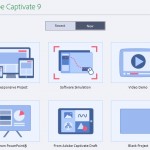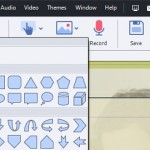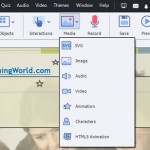Let’s talk about the juggernauts of e-Learning software: Articulate Storyline 2, Adobe Captivate 9 and Trivantis Lectora 16. These three authoring solutions need no introductions, yet it’s crucial to understand how they shape the modern industry landscape and distinguish themselves from one another. Many experts agree that the functionality and interface of all three products are pretty much alike. The goal of this article is to highlight the differences and help the readers in their agonizing choice.
Before we proceed to features, what do the three industry pillars have in common? It should be noted these solutions are designed to produce complex and engaging interactive content. They are sophisticated software products that have some astonishing features. As such, they comply with the latest scalability requirements, responsive design, LMS formats and everything you could expect from advanced authoring tools. Here are some of the benefits all three share:
- Top notch support for interactions
- Drag-and-drop interface
- Great choice of variables and triggers
- Responsive themes
- Impressive character libraries
- HTML5/Flash compatibility
- Interoperability with SCORM/Tin Can standards
- Smooth operation on any mobile device, etc.
When it comes to pricing, however, we are facing a significant disparity. A standard license for Adobe Captivate 9 will set you back around $1,100. Articulate Storyline 2 is available starting at $1,400. Trivantis Lectora 16 tops the big buy charts with a minimal yearly rate of $2,374.
I’m deliberately avoiding any speculation on whether any of these products justify their costs or not. One thing I can say for sure, these rates are not plucked out of the air by the product manufacturers. Articulate, Adobe and Trivantis fans will back me up on this. Further review intends to bring into focus the features that add value to each of the products and make them highly competitive in our devilishly difficult market.
Articulate Storyline 2
Storyline 2 is arguably the easiest product of the three. A multitude of users admits it has a shorter learning curve than the competitors. It’s really simple to get started with, and there is always an option to address the helpful Articulate community with any questions. The interface has a familiar PowerPoint look and feel, which adds up to overall ease of use.
Animations
The built-in animations are a spitting image of PowerPoint animations, though with slightly more control options. The software counts 16 customizable entrance and exit effects, as well as 23 available animations (called triggers in Storyline). The most recent additions are sliders and motion paths, however, there is still a certain deficit on the mobile front. Features like swiping would do a lot of good.
Simulations
This software really excels in simulations. You can record a screencast, i.e. make screen captures, and edit it into a simulation with no extra effort. By default, the program performs records in a dimension corresponding to your course. This gives you great quality but also limits your options in terms of adding other items, like text or button, without overlaying on the page. You can configure output as standalone video or systematic slides, manage when the video starts, crop and trim your content.
Image
There is a plethora of tools for image editing: crop, change color, shadows, borders, reflections, glows, brightness and contrast control, transparency, blend, etc. All this with maintained picture quality.
Multimedia
You can record and edit audio and video when creating a simulation only. The user has to edit the screen and audio as one piece.
Quizzing
The software provides eleven graded options, five free-form options, nine survey options, and a fill in the blank, as well as three pre-made pages displaying the results.
Mobile support
Like the competitors, the program supports mobile publishing to a proprietary player for Apple and Android devices.
Here’s to sum up in a few bullets what sets Articulate Storyline 2 apart from the competitors:
- Availability of slide layers
- Solid software simulations
- Slides can be converted into free-form questions
- Lossless import of presentations into Storyline Project
- An exceptional selection of customizable characters.
Speaking of the cons reported by the community, you’ll probably encounter:
- Stability issues
- No video/YouTube publishing option
- Mediocre support for PowerPoint content
- Minimized player view on mobile devices, which impedes smooth course flow.
Adobe Captivate 9
Adobe’s user club seems to be way less helpful compared to the Articulate and Trivantis communities that allow easy content sharing and interaction. The interface remotely resembles PowerPoint, yet bundled with a typical Adobe solution. The overall impression is somewhat cumbersome if you are not too familiar with the Adobe product line.
The software boasts some great features like geocaching activities and gesture-based interactions. Captivate offers a timeline which helps to show when each elements kicks in so you don’t have to make additional previews. The software features a bunch of widgets for quick interactions and social learning elements.
Adobe Captivate Draft, an iPad app shipped with version 9, helps to transform your ideas into storyboards with question slides, branching logic, etc. Version 9 also adds import from PowerPoint, which the other two contenders have had in place for quite a while. That said, conversion quality may be beyond your expectations so make sure your animations don’t suffer any significant loss.
Animations
This solution is ahead of the game, offering HTML5-ready animations including mobile animation gestures. Effects (the term used in Captivate) are somewhat similar to the PowerPoint offering. The product encompasses a great deal of pre-defined effects such as rotation, glow and straight-line motion as well as new responsive motion paths (linear, custom or scribble).
Simulations
Includes the opportunity to record software simulations, with any dimensions and auto-fit to the screen size. The outcome looks great on both desktop and mobile, yet editing is not nearly as straightforward as in Storyline 2.
Image
Enables the user to tweak brightness, contrast, sharpness, saturation, etc. Naturally, the editing options are pretty basic (just standard features like crop and rotate) as you are supposed to include Photoshop, Fireworks or other solutions from the Adobe Cloud for optimal visualization. However, Captivate 9 offers the ability to create multiple state objects. You can also enrich your content with an image slideshow, and make use of the SVG (Scalable Vector Graphics) format.
Multimedia
You can record and edit audio within the software. The user may easily cut, copy, paste, adjust sound volume and trim clips. Video recording can only be made when creating simulations.
Quizzing
Captivate provides full flexibility with quiz options. Pretty much any interactive object can be included as part of a quiz. With version 9, the user can create responsive drag-and-drop questions, and seven knowledge check queries. It also comes with a new feature that helps construct landing areas and multi-state items to reveal whether the answer was right or wrong, and instruct the learner about possible improvements.
Mobile support
Fits all major mobile devices and features an advanced multi device preview.
Pros
- Solid variables and triggers
- Drag-and-drop functionality
- Output can be published as apps for mobile
- Software simulations
- Multi-device preview option
- Screencasting
- Text-to-speech
- Built-in character and template library
- Responsive design
Cons
- The interface is a bit cluttered and less intuitive
- Needs extra training
- There is no video editor
- There is no app that plays back content offline.
Lectora V16
The vibrant Trivantis community really makes Lectora products stand out from the crowd and attract more fans. It’s easy to chat with other users and share content, and the knowledge base will surely meet your highest expectations.
The interface needs a little getting used to. The learning curve is a bit steeper compared to Articulate Storyline 2 since Lectora delivers more functionality. That said, most objects can be used intuitively, with transparent navigation and helpful wizards available. The ribbon navigation reminds you of PowerPoint yet, generally, the UI is well-balanced and authentic. You can browse content in a tree or thumbnail view. There are 30+ predefined variables and the ability for custom creation. Lectora includes one-click shortcuts to insert page titles and numbering for nifty course development. The standard subscription features the capability to upload up to five courses (from Captivate and Storyline as well!) to the ReviewLink collaboration tool.
Animations
Lectora tops the charts as regards custom animations. 16 entrance and exit effects, and 30 actions that cater to object management, navigation, media, variables and whatnot. You also have the ability to perform actions after a certain delay or triggered by specific events. You can view all the actions made, remove them or shift priorities in a dedicated action pane. Unlike the competitors, Lectora has in its arsenal the mobile animation of swiping.
Simulations
Unfortunately for Trivantis fans, mediocre simulations drag Lectora behind other contenders. With the lack of preset actions, users have to record audio and video, include actions and feedback and make edits on their own. The embedded recording features do not stand up to the standards either. That is, unless you obtain the Inspire package integrated with Camtasia, Snagit, and eLearning Brothers library.
Quizzing
Assessment and quizzing have been Lectora’s strong points throughout its release history. The product confidently outpaces the competition by the number of assessment scenarios. These include nine LMS-compliant options, a host of survey and form variants – and Flash-based mini games. The user can easily set a passing score, randomize and pool questions. The CSV import option also comes in handy when you need to port multiple questions.
Image
Offers cropping, shadows, opacity, reflection, and image handles, as well as multiple state objects. Image quality is preserved.
Multimedia
You can record and modify audio right within the software. Besides cut, copy, paste and trim, you can also fade audio in and out. Webcam video recording and editing is available but somewhat limited. An upgrade to Inspire brings along the full functionality of Camtasia including various publishing options.
Mobile support
Previous versions were sadly lacking responsive design interface or a publishing app. Lectora 16 makes it up to the users by providing all-star visibility and ease-of-use on all mobile devices.
Pros
- Revamped responsive design
- Superb animations, triggers and effects
- Unrivalled variety of quizzing options.
Cons
- Requires a slightly steeper learning curve than Captivate and Storyline
- Low audio and video recording and editing capabilities
- May be very costly.
| Features | Articulate Storyline 2 | Adobe Captivate 9 | Trivantis Lectora 16 |
|---|---|---|---|
| Content authoring | |||
| Audio/video editing | 5 | 4 | 3 |
| Screen capturing / screencasting | 5 | 4 | 4 |
| Recording narrations | 5 | 4 | 5 |
| Interactions | 5 | 4 | 5 |
| Quizzes/surveys/assessments | 4 | 3 | 5 |
| Software simulations | 5 | 5 | 5 |
| Character library | 5 | 5 | 4 |
| Operation with external objects | 5 | 5 | 5 |
| Navigation | 3 | 3 | 4 |
| Publishing | |||
| HTML5 publishing quality | 3 | 5 | 5 |
| Flash publishing quality | 4 | 4 | 5 |
| Publishing to MP4 / YouTube | No | 5 | 4 |
| Mobile support | |||
| Tailored to mobile device players | No | Yes | Yes |
| Mobile app viewer | 5 | No | 5 |
| LMS compliance | |||
| Third party LMS support | 5 | 5 | 5 |
| Integration with proprietary LMS | 5 | 5 | 5 |
| Price | $1,398 | $1,099 | $2,374 |
Bottom line
In this article, we have reviewed standalone authoring software that is independent from third party fundamentals like PowerPoint. Same as the renowned Microsoft tool, they help to create engaging content by arranging various items on your slides, but with much better options for interaction.
Variables, system states and other great features require a certain learning curve to get the utmost of the reviewed solutions. Regardless of complexity, e-Learning experts and instructional designers are happy to jump on the bandwagon of professional content authoring. Good old PowerPoint just doesn’t fly anymore in some strata. The audience is getting much more sophisticated and picky, and there is the issue of responsive design to address. Not to mention LMS support, publishing options, etc.
Talking about Articulate Storyline 2 , Adobe Captivate 9 and Trivantis Lectora 16, which one should you go for?
As always, there is no right answer for all. The key metrics here, in my opinion, are ease of use, expected output and budget. All three authoring products have their upsides and downsides. Storyline, for one, is easy to learn but it lacks the bells and whistles of Captivate or Lectora. Articulate seems to be a great choice for creating nice-looking basics. Lectora is the way to go if your ambition and imagination know no bounds, e-Learning nerds will love the ability to tweak and tune here. However, you can’t help being sticker-shocked every time you check out the Trivantis website. Adobe Captivate is suitable for budget-savvy content developers, yet getting started with it is not that fast and may result in a frustrating experience.
Feel like you are still far from making a final decision? Check out my article on the top 10 authoring tools and extend your perspective with more products out there.
Got something to add to this posting? Give me a shout. Opinions and comments are welcome!
Survey
Last but not least, don’t hesitate to share your preferences.
[democracy id=”15″]

























I agree it’s not easy to choose since all three are really different. I’m a Trivantis fan now, but I use Lectora Online. Subscription costs are still high but not prohibitive as is the case with Lectora 16. In defense of Articulate Storyline, it’s not so basic as the author intends to depict. There are a few hidden gems in there. The problem I see with Storyline is that it doesn’t provide a native look on mobile devices. It does scale down, but come on, it’s the 21st century! Any idea if Articulate is going to do something about it?
Thanks for your comment, Leah!
Articulate does experience some issues on mobile, it always has. My concern is more about the mobile player, though. In fact, I’ve recently tried their Android app again. It actually looks good, you can play back content in full screen or download for offline use. I had a hard time rotating the video, it remained in landscape mode whatever I did. Turns out, it was intended that way. Let’s hope the Articulate community promotes the necessary tweaks for the next update.
Agree with Leah that Storyline is much more powerful than the author makes it out to be… especially if you know a little Javascript.
Great article Scott. Wish I’d read it before jumping on the bandwagon of one of the three Titans. I remember asking a programmer in 1988 ‘Which is the best word processor to get for my new PC?’ His answer was ‘The first one you used.’
Regards
Ward
Thanks Ward! Indeed, looks like not much has changed in 30 years 🙂 Luckily, there is a choice in our field. If you’re interested, check out my extended review of authoring tools.
Scott, Thanks for the article. I was looking for reviews to get myself updated on Storyline vs. Lectora. I was the founder of Trivantis and the creator of Lectora. I left the company after running it for almost 11 years. The price was my decision way back in 1999 (wow, that was a long time ago!) and my primary reason was that Authorware was selling for slightly less than $2495 and I wanted to be a premium product in the market. I must admit that I pulled it out of the air! My focus was much more on the creation of Lectora. For the past two years, I have been working on Elearis, a much simpler and extremely rapid delivery environment for truly responsive mobile learning. If you want the complex objects, build them in either Lectora or Storyline, then deploy them with Elearis. You’ll save a lot of time and money (Elearis is only $100 a year for teachers, $300 for universities and $400 for corporate trainers.
Hi Scott,
I have a question about software simulations in relation to these tools. Are they really the best at creating tutorials for software? Do you have links to examples?
Thanks!
Irena Fayngold
Boston